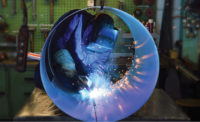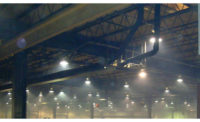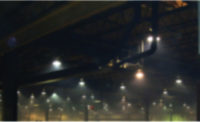Keep your welding environment safe from harmful dust

Most welding and cutting operations generate dangerous fumes and particulates. These processes include manual and robotic welding (MIG, TIG, stick and flux core), arc gouging, manual and automated plasma cutting, and laser cutting. These fumes make shops dirty and worsen indoor air quality, but more importantly they pose a risk to the health and safety of workers.
Here are several important factors you should know to better manage metal processing fumes to maintain a safe metalworking environment.
Common metal processing fume hazards
Like smoke, fumes are really just tiny airborne dust particles. These particles can contain ingredients that irritate eyes and skin and can be toxic when swallowed or inhaled. Common culprits are iron oxide, lead oxide, manganese, nickel, chromium, copper, zinc oxide and cadmium. Welding operations can also produce toxic gases like carbon monoxide, nitrogen dioxide and ozone. Particulate matter generated from welding and metal cutting often has a diameter of 2.5 microns or less, which can lodge deep in the lungs or respiratory ducts and even enter the blood stream.
Metalworking facilities must follow OSHA permissible exposure limits for metal dusts. In addition, many metal dusts can be combustible and often increase the chances of a fire or explosion in the dust collector at your facility. Dust collection systems must be sized correctly and have the proper filters and protection devices to mitigate the risk of a fire or explosion. Even a small amount of dust can have severe consequences.
Dust testing requirements
National Fire Protection Agency (NFPA) standards require a dust hazard analysis (DHA) for any facilities that generate, handle or store combustible dust. Manufacturers must demonstrate that process dust is not combustible, so it is important for you to have dust tested by a valid third-party testing lab and keep records on file proving that it is not combustible.
If tests show that the facility has combustible dust, NFPA 652 requires the company to complete a DHA of the dust collection systems. Have this report ready to present to the local fire marshal or other authority having jurisdiction, as well as insurance companies, upon request. In addition, explosion venting equipment must be inspected at least annually and documented results kept on file.
Dust testing will tell you if your dust has a Kst and Pmax value — how much pressure an explosion will generate and how fast the explosion will travel. The data tells you how explosive your dust is and helps determine how to best mitigate the risk of an incident. If OSHA determines that even a very low Kst dust is present, and you don’t have a dust collector with explosion protection, you run the risk of receiving a citation.
Exposure regulations
OSHA requires companies to control dust emissions in indoor workplaces and to comply with legal limits set for each ingredient and material. If no legal limits are applicable, the company must define in writing and implement its own environmental safety plan. In addition, the NFPA plays a major role in recommending standards and guidelines for managing combustible dusts. If a company doesn’t follow these guidelines, they can be fined by OSHA.
OSHA sets the permissible exposure limit (PEL) for metal dust, which is defined as the maximum air concentration to which a worker can be safely exposed for an eight-hour shift, 40-hour work week without potentially suffering adverse health effects. When initial monitoring reveals exposures above the action level, facility operators will have to implement additional requirements per OSHA. PEL is expressed as a time-weighted average in micrograms per cubic meter of air (μg/m3) or milligrams per cubic meter of air (mg/m3). Here are some examples of OSHA PELs for metal cutting fume/dust:
- Cadmium fume: 5 μg/m3 (2.5 μg/m3 action level)
- Hexavalent chromium fume: 5 μg/m3 (2.5 μg/m3 action level)
- Zinc oxide fume: 5 mg/m3
- Iron oxide fume: 10 mg/m3
- Manganese fume: 5 mg/m3
Capture hazardous fumes
The best way to reduce hazardous metalworking fume exposure is to install dust collection systems with high-efficiency primary cartridge-style filters and secondary safety filters. Primary filter media should be selected for each application based on the dust particle size, flow characteristics, quantity and distribution.
It is recommended that a secondary safety monitoring filter be used, such as a HEPA filter. Secondary filters (safety monitoring filters) prevent hazardous fumes from discharging to the atmosphere in the event of a primary filter malfunction. They can prevent return air ducting contamination and the associated costs of cleaning hazardous dust leakage.
There are three general types of cartridge dust and fume collection systems:
- Source capture systems work well for applications involving small parts and fixture welding. They typically use flexible source capture arms, slotted fume hoods or smaller slotted hoods with side shields on a workbench operation.
- Enclosures and canopy hoods are often used in medium-sized-footprint areas, about 12 feet by 20 feet or less. You can add curtains or hard walls to the sides of a hood to create a booth or enclosure, as long as they don’t interfere with your workspace. With robotic weld cells and hard automation, you can use a full enclosure over and around the application.
- Ambient systems are often used for larger work areas that perform multiple operations because they filter all the air in the shop using a central system or multiple smaller collectors. The dust and fume collector may also require a bank of secondary HEPA safety monitoring filters for added filtration and backup protection, particularly where air is returned indoors downstream of the collector. Although ambient systems help to control dust, they do not remove fumes from the breathing zone, so workers might have to wear personal protective equipment or use fans to direct fumes away from the area.
Protect against an explosion in the dust collector
There is always the potential for an explosion inside a dust collector because it is a closed vessel containing finely divided dry dust particles. An explosion usually begins when a suspended cloud of combustible dust is present in high concentration inside the collector. As the fan draws large volumes of air into the collector, it can also pull in a spark, ember or other source of fire. When this ignition source meets the dust cloud, it can trigger an explosion. The source of the spark may be a production process like welding, faulty equipment or static electricity.
Although these explosions can’t always be prevented, they can be contained and minimized using explosion protection equipment. The NFPA provides guidelines to design, locate, install and maintain these explosion protection devices to minimize harm to personnel as well as mitigate structural and mechanical damage.
Placing dust collectors outside is a safe option if you properly isolate the dust collector and provide explosion venting directed away from buildings and populated areas. However, it isn’t always feasible to place them outside. Dust collectors placed indoors must have the appropriate explosion protection system and a designated safe operating area if they will handle any combustible dusts.
The most common method of explosion protection utilizes passive isolation (inlet, outlet and waste discharge) with explosion venting, which is often the most cost-effective. In a passive explosion protection system, the explosion vent functions as a weak element in the dust collector’s pressure envelope. It relieves internal combustion pressure (back pressure) to keep the collector from blowing up into pieces.
While explosion protection with venting will usually save the dust collector from being a total loss, the collector can sustain major internal damage. Nonetheless, if personnel remain safe and facility structural damage is minimized, the explosion protection equipment has done its job.
Size vents and discharge ducts
NFPA 68 Chapters 7 through 9 provide the calculations to use for properly sizing explosion vents, vent discharge ducts and other components. An experienced dust collector supplier will follow the vent sizing equations in Chapter 8 (Venting of Deflagrations of Dusts and Hybrid Mixtures). You should also receive a calculations sheet that becomes part of the documentation you keep on file to demonstrate your facility’s compliance. The NFPA also allows performance-based solutions from the dust collector supplier for this type of equipment.
Recirculate air back into the work environment
Recirculating heated or cooled air back into the workspace can provide significant energy savings and eliminate the cost to replace that conditioned air. Containing the air indoors also avoids the time-consuming permitting involved when contaminated air is exhausted outside. This can be safely done even if the facility handles explosive dust by outfitting the dust collector with an integrated safety monitoring filter. This helps isolate the downstream equipment from the progression of a flame front during an explosion.
Final thoughts
Capturing, conveying and containing metal processing fumes create a safe workplace for employees. You can achieve this by testing and understanding your dusts’ properties, using collectors designed specifically for your facility, protecting against explosion risk and following OSHA and NFPA regulations.
Looking for a reprint of this article?
From high-res PDFs to custom plaques, order your copy today!









